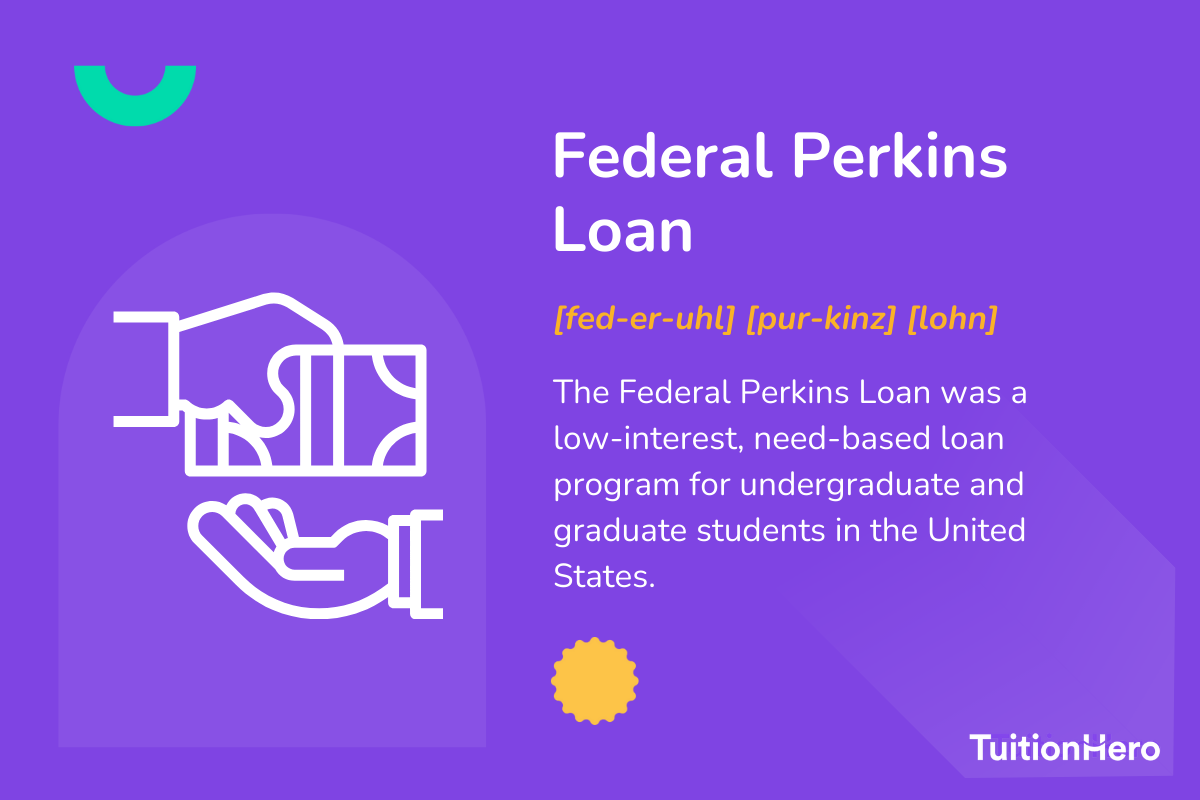Advertiser Disclosure
Last update: November 17, 2024
9 minutes read
What Are Federal Perkins Loans?
Explore your options for Federal Perkins Loans, including forgiveness and repayment plans.

By Brian Flaherty, B.A. Economics
Edited by Rachel Lauren, B.A. in Business and Political Economy
Learn more about our editorial standards



By Brian Flaherty, B.A. Economics
Edited by Rachel Lauren, B.A. in Business and Political Economy
Learn more about our editorial standards
Have you ever wondered what Federal Perkins Loans are? These were loans offered for students in great financial need. In this post, you'll learn about Federal Perkins Loans, how they worked, and the options for borrowers still paying them off.

Key takeaways
- Perkins Loans were made available to students with extreme financial need, though the program ended in 2018
- Loan terms were generous, with a fixed 5% interest rate and no origination fees
- Your account on StudentAid.gov will show if you have Perkins Loans
What are Federal Perkins Loans?
Federal Perkins Loans were a type of low-interest federal loan offered to students with extreme financial need. They were provided by the educational institution the student attended, at a fixed 5% interest rate, and had the advantage of being subsidized.
What made Perkins Loans different was that the school gave the money, not a bank or the government directly. This meant students paid back the loan to the school.
The goal was to help students with extreme financial need to be able to afford college. It’s important to know that the Federal Perkins Loan Program ended, and they aren't giving new loans anymore. If you do already have a loan, you still need to pay it back as agreed.

Who could get Perkins Loans?
Perkins Loans used to help students who didn't have enough money to pay for college. If a student or their family couldn't afford college without help, they could qualify for these loans.
To see if you were eligible, you had to fill out a form called the Free Application for Federal Student Aid (FAFSA). To be eligible for a Perkins Loan, you needed to meet the following criteria:
- Be an undergraduate, graduate, or professional student with extreme financial need
- Be enrolled full-time or part-time
- Attend a school that participates in the Federal Perkins Loan Program
What were the loan limits and terms?
Borrowing limits for Federal Perkins Loans were determined by the student’s financial needs and the school’s funding availability. Undergraduates could borrow up to $5,500 annually, with a total limit of $27,500. Graduate students could borrow up to $8,000 annually, capped at $60,000, including any undergraduate Perkins Loans.
The interest rate for Federal Perkins Loans was fixed at 5% and the repayment term was 10 years. Repayment on the loan started 9 months after the student graduated, left school, or dropped below half-time status.
How do I know if I have Perkins Loans?
To find out if you have Federal Perkins Loans, you can follow these steps:
- Check your loan documents: Review any loan documents you received when you first took out student loans. These documents usually include information about the types of loans you have.
- Contact your loan servicer: If you're not sure who your loan servicer is, you can find this information on the National Student Loan Data System (NSLDS) website (https://nsldsfap.ed.gov/). You’ll need your Federal Student Aid (FSA) ID to access this information.
- Review NSLDS: The NSLDS website has a centralized database of your federal student aid information, including Perkins Loans. Log in with your FSA ID and review the loan details to see if Perkins Loans are listed.
- Contact your school’s financial aid office: If you attended a school that participated in the Federal Perkins Loan Program, you can contact the financial aid office at your school. They should have records of your Perkins Loans and can provide information on your loan status.
- Review your credit report: Perkins Loans should be listed on your credit report. You can get a free credit report from each of the 3 major credit bureaus (Equifax, Experian, and TransUnion) once a year. Check your credit report to see if Perkins Loans are listed.
- Call the Federal Student Aid Information Center (FSAIC): You can contact the FSAIC at 1-800-4-FED-AID (1-800-433-3243) to ask about your federal student loans, including Perkins Loans.

TuitionHero Tip
Remember that the Federal Perkins Loan Program has expired, and no new loans are being issued. If you previously had Perkins Loans, you will still need to repay them according to the terms of your agreement.
Who manages my Perkins Loans?
Your Perkins Loans are usually taken care of by your school. Unlike other federal student loans, the school handles Perkins Loans directly.
The school has a special office or department, often called the "Perkins Loan Servicer" or the "Bursar's Office," that looks after and manages Perkins Loans. Some might have shifted to the Department of Education, especially if there was a default.
What repayment options are available for Perkins Loans?
Repayment options for outstanding Perkins Loans include:
- Standard Repayment: This is the most straightforward option. You make fixed monthly payments over a 10-year period.
- Graduated Repayment: Payments start off lower and then gradually increase, usually every 2 years. This can be helpful if your income is expected to rise over time. Note that you’ll need to request approval from your school to use a graduated repayment plan for a Perkins loan.
- Loan consolidation: You can consolidate your Perkins Loans into a Direct Consolidation Loan. This may make you eligible for other repayment plans not available with Perkins Loans, but be aware that you might lose certain benefits associated with Perkins Loans.
- Income-Contingent Repayment (ICR): Your monthly payments are based on your income, family size, and loan amount. They can change as your income changes, and any remaining balance may be forgiven after 25 years. ICR plans are only available if you consolidate your Perkins loan into a Direct Loan.
- Public Service Loan Forgiveness (PSLF): If you work in qualifying public service jobs and make 120 qualifying monthly payments under a qualifying repayment plan, the remaining balance on your Perkins Loans may be forgiven. This type of forgiveness requires consolidation.
- Teacher Loan Forgiveness: Teachers who meet specific requirements and work in low-income schools may be eligible for loan forgiveness on a portion of their Perkins Loans, including up to the full amount over a course of 5 years.
- Cancellation for certain professions: Certain professions, like teaching, nursing, or serving in the Peace Corps, may qualify for loan cancellation for Perkins Loans.
How can I get Perkins Loans forgiven?
One of the perks of Perkins Loans was the possibility of total loan forgiveness. If you're in public service, it could help you start fresh without any debt.
However, Perkins does not qualify for income-driven repayment forgiveness - for this, you'll need to consolidate the loan. Here is how to qualify for forgiveness under the Perkins loan:
- Public service jobs may lead to 100% forgiveness
- Must work 4 to 7 years, depending on the job
- Forgiveness starts after the first year in qualifying positions
- Program specifics vary by profession
Compare private student loans now
TuitionHero simplifies your student loan decision, with multiple top loans side-by-side.
Compare Rates
Should I consolidate my Perkins Loans?
Combining your Perkins Loans has some advantages. It makes things simpler by giving you just one monthly payment instead of several, and you get more choices for repaying.
It could also improve your chances of getting loan forgiveness. But, there are things to think about.
You might lose special perks that come with Perkins Loans, and you might end up paying more in interest over the life of the loan.
Even if your monthly payments are less, stretching out how long you repay could mean paying more overall. If you consolidate too soon, you might have to start repaying right away, losing the usual 9-month grace period.
Before you decide to do it, it's smart to talk to your loan servicer. They can help you figure out what option works best for your money situation and goals.
How does the IDR account adjustment affect Perkins Loans?
The IDR account adjustment is a special program that adds to your repayment period count to help you reach loan forgiveness faster. If the government has your Perkins loans, you'll get this adjustment automatically.
But if your FFEL, Perkins, or HEAL Program loans are held by a private company, they don't qualify for this one-time adjustment. To make them eligible and get the adjustment benefits, you had to apply for a Direct Consolidation Loan before April 30, 2024.
Dos and don'ts of managing Perkins Loans
Understanding and managing your Perkins Loans can be easy when you know what to do and what not to do. Follow these tips to stay on the right track with this special type of loan.
Do
Do check if you have Perkins loans by logging into StudentAid.gov
Do explore loan forgiveness options if you work in public service
Do meet deadlines for potential programs like the IDR account adjustment
Do talk to your school or loan servicer for specific repayment options
Do consider the pros and cons of loan consolidation
Don't
Don't forget your FSA ID when checking loan details
Don't assume all public service jobs qualify for loan forgiveness
Don't miss the April deadline for consolidation if your school holds the loan
Don't overlook deferment or forbearance options during tough times
Don't rush into consolidation without understanding the effect on loan forgiveness
Advantages and disadvantages of Federal Perkins Loans
Perkins Loans gave lots of students a shot at college even when money was tight. Like any money tool, they had pros and cons that borrowers needed to figure out.
- Subsidized interest during school and grace periods
- Fixed interest rate at 5%, providing payment stability
- Potential for up to 100% loan forgiveness for qualifying public service jobs
- 9-month grace period after school, giving you breathing room before repayment starts
- No origination fees, keeping borrowing costs down
- No more availability since the program has ended
- Forgiveness and repayment options can be complex and vary by school
- Forgiveness eligibility is tied to specific jobs and lengths of service (Perkins loans do not qualify for income-driven repayment - they need to be consolidated first)
- Consolidating loans might remove the special fast forgiveness that only applies to Perkins loans.
- Choosing between school loans and government loans can be a bit confusing.

Why trust TuitionHero
At TuitionHero, we make paying for college easier. We offer services like Private Student Loans and Student Loan Refinancing. We help you understand things like loan repayments and scholarships. Plus, we can help you build your credit score with our Credit Card Offers.
Frequently asked questions (FAQ)
Perkins Loans used to be a big help for students, but they stopped giving them out in 2018. If you're looking for other ways to support your education, like private student loans or scholarships, we can help you at TuitionHero.
If your school shuts down and you have a Perkins Loan, there are rules to help you out. In certain situations, you might be able to get the loan canceled, and we at TuitionHero can help you understand how to do that.
The COVID-19 payment pause helped a lot of people. But Perkins Loans might have different rules because they're tied to schools.
To know what's up, talk to your servicer. They have the latest information. And remember, we're here to help you figure out all the ways you can get relief.
Final thoughts
Perkins Loans helped a lot of students with the costs of higher education. Even though the Perkins Program is no longer available, finding ways to afford college is still possible.
Things might change, but with the right help, you can plan how to repay loans, get forgiveness, or explore other funding options. TuitionHero is here to guide you with resources and support. Head towards a bright future, and remember to ask for help whenever you need it.
Source
- NYS Higher Education Services Corporation - How Much Can You Borrow?
- Federal Perkins Loan Repayment | Ohio University
- Federal Student Aid Information Center (FSAIC)
- Payment Count Adjustments Toward Income-Driven Repayment and Public Service Loan Forgiveness Programs | Federal Student Aid
- Federal Student Aid - Public Service Loan Forgiveness Program
- Federal Perkins Loan Cancellation and Discharge
Author

Brian Flaherty
Brian is a graduate of the University of Virginia where he earned a B.A. in Economics. After graduation, Brian spent four years working at a wealth management firm advising high-net-worth investors and institutions. During his time there, he passed the rigorous Series 65 exam and rose to a high-level strategy position.
Editor

Rachel Lauren
Rachel Lauren is the co-founder and COO of Debbie, a tech startup that offers an app to help people pay off their credit card debt for good through rewards and behavioral psychology. She was previously a venture capital investor at BDMI, as well as an equity research analyst at Credit Suisse.
At TuitionHero, we're not just passionate about our work - we take immense pride in it. Our dedicated team of writers diligently follows strict editorial standards, ensuring that every piece of content we publish is accurate, current, and highly valuable. We don't just strive for quality; we aim for excellence.
Related posts
While you're at it, here are some other college finance-related blog posts you might be interested in.
Shop and compare student financing options - 100% free!

Always free, always fast
TuitionHero is 100% free to use. Here, you can instantly view and compare multiple top lenders side-by-side.

Won’t affect credit score
Don’t worry – checking your rates with TuitionHero never impacts your credit score!

Safe and secure
We take your information's security seriously. We apply industry best practices to ensure your data is safe.
Finished scrolling? Start saving & find your private student loan rate today





